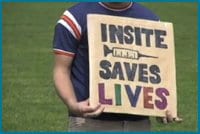A year after the term “harm reduction” disappeared from the federal governments’ drug strategy, Public Health is quietly funding $7.5 million of community-based harm reduction work.
Public Health may not be using the term in communiqués any longer, but top bureaucrats are still being briefed on the topic, according to internal documents obtained by Capital Xtra under an access to information request.
The Powerpoint presentation to the Policy Adivsory Committee, dated Feb 25, 2008, asks whether PHAC “has a role to play” on harm reduction. It then details some of the harm reduction programs the government funds through its grants and contributions (Gs&Cs) program.
“More than $3.5 million of Gs&Cs support activities related to harm reduction,” the document reads. “Under the hepatitis C Program, $4 million of the annual budget supports activities related to harm reduction, since intravenous drug users is a driving factor behind the vast majority of new hepatitis C cases in Canada.”
The next six slides were blacked out before they were released, but hepatitis C funding was renewed less than two months later.
In response to questions from Capital Xtra, PHAC spokesperson Michael Tansey issued a one-sentence statement.
“PHAC supports a broad range of community partners,” it says, “and federal funding is based on assessments of each individual project’s merits.”
The gay community pioneered the harm reduction approach in the 1980s, in the midst of the AIDS epidemic, when others were preaching an abstinence- and monogamy-only solution.
Harm reduction remains an important plank for the gay movement, because it looks at people’s lives as they actually are and tries to help them — instead of telling them they must change in order to access health and other services. In the early ’90s, the harm reduction model became one of the four pillars of drug policy.
Monique Doolittle-Romas is the executive director at the Canadian AIDS Society (CAS). She explains the harm reduction model used by many AIDS service organizations.
“We need to recognize that drug use exists and may always exist,” she says. “Complete abstinence is not the goal of our work, because it is not considered realistic.”
Their goal, instead, is to reduce the spread of HIV and hepatitis C among drug users.
The Public Health document lists harm reduction programs the feds have killed since the Conservatives took power in 2006. They include removing harm reduction from the national drug strategy and ending the safer tattooing pilot project in prisons. A third bullet lists the expiry of the federal exemption for Vancouver’s safe injection site, but justice Ian Pitfield of the BC Supreme Court ruled on May 28 that the site must stay open. Two other bullets have been blacked out.
Appearing at a Parliamentary committee May 29, minister Tony Clement chastised harm reduction programs for aiding criminal drug users.
“When we speak the plain truth, call crimes what they are, we are standing up for and showing respect for the rule of law,” he told the committee. “There always have been and there always will be people who break the law. That doesn’t mean we abandon the law — chaos would reign if we did.”
Clement’s tough talk could put the future of community-based harm-reduction programs in jeopardy. But groups who fight HIV aren’t backing off.
Lynne Belle-Isle is co-author of Learning from Each Other, a report by the Canadian Harm Reduction Network and CAS. It focusses on the harm reduction programs in nine different Canadian cities.
“We realized that all over Canada there are many different groups all trying to do the same or similar things when it comes to harm reduction, although they were all doing them differently” says Belle-Isle. “So instead of trying to recreate the wheel, we wanted to find a way where groups could kind of combine forces, and learn from what others have been doing.”
Unlike a lot of the research and much of the press surrounding harm reduction, Learning from Each Other includes first-hand accounts from current drug users about accessing services.
“If you’re working on something to help people who are using drugs, it only makes sense to include them in the process,” says Belle-Isle, referring to the focus groups’ pervasive theme of ‘nothing about us without us’. “The whole basis of harm reduction is treating people with respect and dignity.”
Dave, a recovering addict and former frontline worker spoke about his own experience with harm reduction programs at a press conference for the report’s release on Jun 17.
“I think the opponents to harm reduction strategies know what the real issues are, but they’re playing on public fears in order to promote their own hidden agendas,” says Dave, who is living with HIV and hep C himself. “They are actually adding to the stigmatization of addicts.”


 Why you can trust Xtra
Why you can trust Xtra


